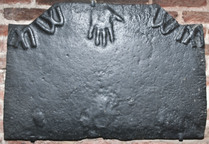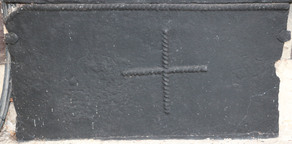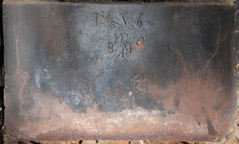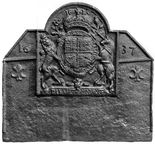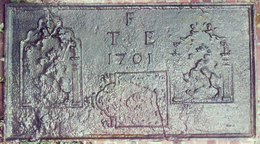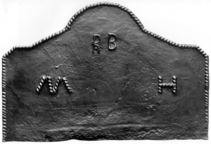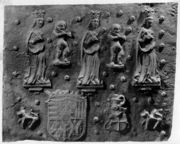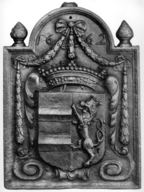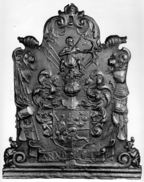-
1113
Description: Quasi-rectangular with a three-facetted arch; top centre, left hand print; around each shoulder, M W mirrored.
Notes: The likelihood is that the M and W are formed of a double-V (virgo virginum) intended to symbolise the Virgin Mary and have an apotropaic (evil-averting) purpose. It may be of significance that hand prints seen on firebacks are always of the left hand.
Inscription: MW WM
- Decoration tags:
- rectangular with triple-facetted arch (shape)
- none (edging)
- simple stamps
- individual letters
- apotropaic
- text
- humans
Manufactured: in the early-17th century possibly in the Weald area of England.
Current location: in private hands, Crowborough, East Sussex, England.
- Attached to series:
- Hand print firebacks
-
1114
Description: Rectangular; twisted rope edging (top and two-thirds down sides); rope length across each top corner.
Notes: The twisted rope lengths are particularly well defined.
- Decoration tags:
- rectangular (shape)
- rope (edging)
- simple stamps
- objects
Manufactured: in the mid- to late-16th century in the Weald area of England.
Current location: in private hands, Crowborough, East Sussex, England.
- Attached to series:
- Rope design firebacks
-
1115
Description: Fragment; canted rectangular; twisted rope edging (topand sides); central cross of twisted rope.
Notes: Sections missing at both ends.
- Decoration tags:
- rectangular with canted top corners (shape)
- rope (edging)
- simple stamps
- apotropaic
- objects
Manufactured: in the 16th century in the Weald area of England.
Current location: in private hands, Crowborough, East Sussex, England.
- Attached to series:
- Rope design firebacks
-
911
Description: Plain rectangular plate; no edging; top centre, date with '7' reversed; below date, initials in triad.
Notes: The reversed '7' indicates that the numerals, and probably the letters, had no backing; the initials are probably those of a husband and wife whose surname began with 'H'.
Inscription: 1676 / BHM
- Decoration tags:
- rectangular (shape)
- none (edging)
- carved stamps
- individual letters
- individual numbers
- text
Manufactured: in 1676 in the Weald area of England.
Current location: in private hands, Crowhurst, East Sussex, England.
- Attached to series:
- Date & initials firebacks
-
955
Description: Composite; canted arched rectangular shape; armorial fireback, cavetto edging, with Stuart Royal arms, garter, supporters, crown and motto, and 1620 date above crown; this overlies a canted rectangular plate, with twisted rope edging, fillet; two quasi-horizontal fillets from the tops of the vertical sides to the middle of the armorial fireback separate the back into two uneven parts, the date in the top part, split by the armorial, and a fleur-de-lys at the top of the lower part, also separated by the armorial.
Notes: The use of the armorial back is seen frequently and probably dates from 1619, though the date is usually altered; in this case the alteration does not match the more prominent date for the fireback; photograph ex T. Crowther & Son Ltd, 1985.
Inscription: 16 29 / HONI SOIT QUI MAL Y PENSE / 16 37 / DIEV ET MON DROIT
Arms: English Stuart royal
- Decoration tags:
- rectangular with canted top corners and round arch (shape)
- rope (edging)
- carved stamps
- whole carved pattern
- composite
- individual numbers
- heraldic
- armorial
- royal
- text
Manufactured: in 1637 possibly in the Forest of Dean area of England.
Current location: not known.
-
1011
Description: Rectangular shape with cavetto-moulded edging; top centre, initials in triad with date below; on each side, stamp formed of a small, wavy-arched rectangular fireback bearing a lion rampant between pilasters surmounted by burning cauldrons, beneath two mirrored putti holding branches; beneath the date, a stamp formed of a small arched-rectangular fireback laid on its left side with a burning cauldron on each shoulder and the faint figure of a bird in the centre.
Notes: The two identical fireback stamps on either side of the inscription have been noted elsewhere (see no. 210 Late Pictorial series 5); the centre and right fireback stamps have been impressed insufficiently; illustration from Country Life advertisement by T. Crowther & Son Ltd, 18 Oct 1984.
Inscription: TFE [triad] / 1701
- Decoration tags:
- rectangular (shape)
- cavetto (edging)
- composite
- individual letters
- individual numbers
- pictorial
- architectural
- text
- animals
Manufactured: in 1701 in England.
Current location: not known.
- Attached to series:
- Composite firebacks
- Late pictorial series (all)
- Late pictorial series 5
-
1024
Description: Canted rectangular shape with canted arch; probable twisted leather edging (top and sides); top centre, initials RB formed of individual carved letters; centre, widely spaced, letters M H formed of short lengths of probable twisted leather.
Notes: An unusually shaped fireback
Inscription: RB / M H
- Decoration tags:
- rectangular with canted top corners and round arch (shape)
- twisted leather (edging)
- simple stamps
- carved stamps
- individual letters
- text
Manufactured: in the early- to mid-17th century in England.
Current location: not known.
- Attached to series:
- Initials only firebacks
-
1025
Description: Quasi-rectangular shape; top, crowned robed statuary figure holding a book, repeated three times, interspersed with a naked child statuary figure playing a flute; bottom, shield and coronet to left, small shield, helm and crest to right, all between a crude dog figure repeated on each side; the whole plate dotted randomly with a repeated small gadrooned bead stamp.
Notes: The figures are from wall-mounted statuary. The shield and coronet are those of the Duchy of Lorraine prior to 1538; blazon: Quarterly, 1. barry of eight gules and argent (Hungary) impaling azure semy-de-lis Or a label gules (Naples); 2. argent a cross potent and four crosslets Or (Jerusalem) impaling Or four pallets gules (Aragon); 3. azure semy-de-lis Or a bordure gules (Valois-Anjou); 4. azure crusilly fitchy, two barbels addorsed Or (Bar); overall an inescutcheon Or a bend gules three alerions argent (Lorraine). The figure holding the book is that of St Catherine of Siena (see von den Driesch, pp. 220, 222).
Arms: Duchy of Lorraine
- Decoration tags:
- rectangular (shape)
- none (edging)
- carved stamps
- heraldic
- historical
- armorial
- animals
- humans
- objects
Manufactured: in the early-16th century in the Lorraine area of Germany.
Current location: not known.
- Attached to series:
- Foreign armorial firebacks
-
1193
Description: Arched rectangular shape with a 'flame' on each shoulder and a broken one on top of the arch; fillet and cavetto-moulded edging; lower centre, shield with impaled arms, dexter two bars in high relief, sinister a crowned lion rampant, all in front of a foliate cartouche terminating in mirrored swirls below the shield; above, a beaded coronet; in the arch, the date split either side of mirrored foliate swags suspended from a bow and from a flower in each shoulder, with a short central vertical swag above the coronet.
Notes: A fireback in high relief with an inserted date.
Inscription: 16 62
Arms: not known
- Decoration tags:
- rectangular with round arch (shape)
- fillet and cavetto (edging)
- whole carved pattern
- individual numbers
- heraldic
- armorial
- text
Manufactured: in 1662 in France.
Current location: English Salvage Ltd, North Road, Leominster, Herefordshire, England.
- Attached to series:
- Foreign armorial firebacks
-
1030
Description: Quasi-arched rectangular shape upon a moulded plinth; on a background comprising foliate swirls, a central shield, helm, coronet and elaborate mantling, with a crest of a forward facing centaur armed with a drawn bow pointed to the sinister side, and behind which are six pennons, three each side display in a v-shape; to the left, a triumph comprising a drum, draped flag on pole, concealing an arquebus, halberd and breastplate, and a broad-brimmed hat with feather; to the right, a triumph comprising a drum, a breast plate and tassets, a powder horn, and partially concealed arquebus, sword and spear, and a broad-brimmed hat with feather; at the base, a horizontal fillet with scrolled ends and squatting 'rodents'.
Notes: An uncharacteristic fireback designed and cast for the family of Joan Huydecoper (1625-1704). A variant without the base plinth and 'rodents' is in the collection of Museum Rotterdam (inv. 15224).
Inscription: ANNO 1647
Arms: Joan Huydecoper
- Decoration tags:
- rectangular with ornate arch (shape)
- complex individual (edging)
- whole carved pattern
- heraldic
- armorial
- text
- humans
- objects
Manufactured: in 1647 possibly in the Siegerland area of Germany.
Current location: Rijksmuseum, Museumstraat, Amsterdam South, North Holland, Netherlands.
Museum number: BK-1978-19 (part of the Rijksmuseum museum group)
- Attached to series:
- 'Dutch' Miscellaneous Firebacks
- Foreign armorial firebacks
